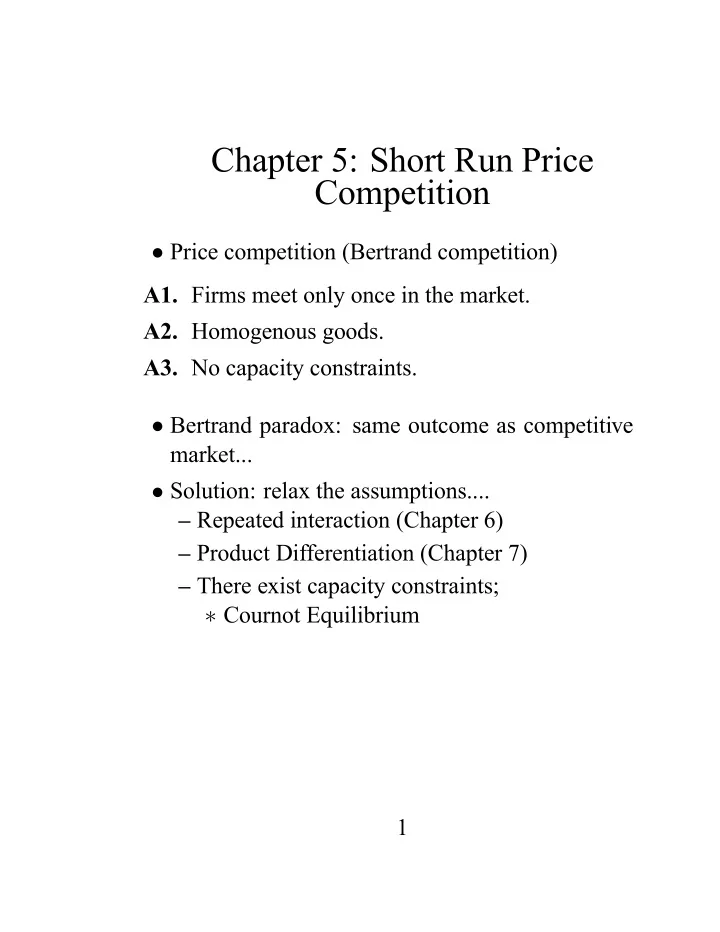

Chapter 5: Short Run Price Competition • Price competition (Bertrand competition) A1. Firms meet only once in the market. A2. Homogenous goods. A3. No capacity constraints. • Bertrand paradox: same outcome as competitive market... • Solution: relax the assumptions.... – Repeated interaction (Chapter 6) – Product Differentiation (Chapter 7) – There exist capacity constraints; ∗ Cournot Equilibrium 1
1 The Bertrand Paradox • Duopoly, n = 2 • Because identical goods, consumers buy from the supplier that charges the lowest price. • Market demand: q = D ( p ) • Marginal cost: c • Firm i ’s demand is D ( p i ) if p i < p j 2 D ( p i ) if p i = p j 1 D i ( p i , p j ) = if p i > p j 0 • Firm i ’s pro fi t is Π i ( p i , p j ) = ( p i − c ) D i ( p i , p j ) De fi nition A Nash equilibrium in price ( Bertrand equilibrium ) is a pair of prices ( p ∗ 2 ) such that each 1 , p ∗ fi rm i ’s price maximizes the pro fi t of i , given the other fi rm’s price. Π i ( p ∗ i , p ∗ j ) ≥ Π i ( p i , p ∗ j ) for i = 1 , 2 and for any p i . 2
• The Bertrand Paradox (1883): The unique equilibrium is p ∗ 1 = p ∗ 2 = c . • Firms price at MC and make no pro fi t. • If asymmetric marginal costs c 1 < c 2 , it is no longer an equilibrium. – p = c 2 ( fi rm 1 sets price lower than c 2 to get the whole market) – fi rm 1 makes Π 1 = ( c 2 − c 1 ) D ( c 2 ) and fi rm 2 has no pro fi t. 3
2 Solutions to Bertrand Paradox 2.1 Repeated Interaction (relax A1) • Chapter 6 • If fi rms meet more than once, ( p ∗ 1 , p ∗ 2 ) = ( c, c ) is not the only equilibrium. • Collusive behavior can be sustain by the threat of future losses in a price war. 2.2 Product Differentiation (relax A2) • Chapter 7 • With homogenous product: at equal price, con- sumers are just indifferent between goods. • If goods are differentiated: ( p ∗ 1 , p ∗ 2 ) = ( c, c ) is no longer an equilibrium. • Example: spacial differentiation 4
2.3 Capacity Constraints (relax A3) • Edgeworth solution (1887). • If fi rms cannot sell more than they are capable of producing: ( p ∗ 1 , p ∗ 2 ) = ( c, c ) is no longer an equilibrium. • Why? If fi rm 1 has a production capacity smaller than D ( c ) , fi rm 2 can increase his price and get a positive pro fi t. • Example: 2 hotels in a small town, number of beds are fi xed in SR. • The existence of a rigid capacity constraint is a special case of a decreasing returns-to-scale technology. • Why? Firm 1 has a marginal cost of c up to the capacity constraint and then MC = ∞ . 5
Recommend
More recommend